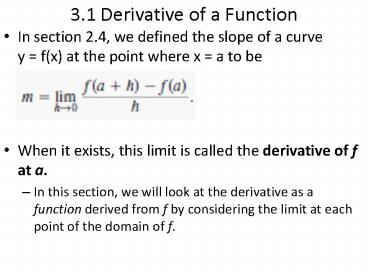3.1 Derivative of a Function - PowerPoint PPT Presentation
1 / 16
Title:
3.1 Derivative of a Function
Description:
3.1 Derivative of a Function In section 2.4, we defined the slope of a curve y = f(x) at the point where x = a to be When it exists, this limit is called the ... – PowerPoint PPT presentation
Number of Views:121
Avg rating:3.0/5.0
Title: 3.1 Derivative of a Function
1
3.1 Derivative of a Function
- In section 2.4, we defined the slope of a curve
y f(x) at the point where x a to be - When it exists, this limit is called the
derivative of f at a. - In this section, we will look at the derivative
as a function derived from f by considering the
limit at each point of the domain of f.
2
- The domain of f , the set of points in the
domain of f for which the limit exists, may be
smaller than the domain of f. If f (x) exists,
we say that f has a derivative (is
differentiable) at x. A function that is
differentiable at every point of its domain is a
differentiable function.
3
Applying the Definition
- Differentiate (that is, find the derivative of)
f(x) x³.
4
- After we find the derivative of f at a point x
a using the alternate form, we can find the
derivative of f as a function by applying the
resulting formula to an arbitrary x in the domain
of f.
5
Applying the Alternate Definition
- Differentiate using the alternate
definition. - At the point x a,
6
Notation
- There are many ways to denote the derivative of a
function y f(x). Besides f(x), the most
common notations are these
7
Relationships Between the Graphs of f and f
- When we have the explicit formula for f(x), we
can derive a formula for f(x) using methods like
those in examples 1 and 2. - The functions are encountered in other ways
graphically, for example, or in tables of data. - Because we can think of the derivative at a point
in graphical terms as slope, we can get a good
idea of what the graph of the function f looks
like by estimating the slopes at various points
along the graph of f.
8
Graphing f from f
- Graph the derivative of the function f whose
graph is shown in Figure 3.3a. Discuss the
behavior of f in terms of the signs and values of
f.
9
Graphing f from f
- Sketch the graph of a function f that has the
following properties - 1. f(0) 0
- 2. the graph of f, the derivative of f, is as
shown. - 3. f is continuous for all x.
10
Solution
- To satisfy property 1, begin with a point at the
origin. - To satisfy property 2, consider what the graph of
the derivative tells us about slopes. - To the left of x 1, the graph of f has a
constant slope of -1 therefore draw a line with
slope -1 to the left of x 1, making sure it
goes through the origin. - To the right of x 1, the graph of f has a
constant slope of 2, so it must be a line with
slope 2. There are infinitely many such lines,
but only one the one that meets the left side
of the graph at (1 , -1) will satisfy the
continuity requirement.
11
Graphing the Derivative from Data
- Discrete points plotted from sets of data do not
yield a continuous curve, but we have seen that
the shape and pattern of the graphed points
(scatter plots) can be meaningful. - It is often possible to fit a curve to the points
using regression techniques. - If the fit is good, we could use the curve to get
a graph of the derivative visually.
12
One-Sided Derivatives
- A function y f(x) is differentiable on a closed
interval a , b if it has a derivative at every
interior point of the interval, and if the limits - exist at the endpoints.
- In the right-hand derivative, h is positive and
ah approaches a from the right. - In the left-hand derivative, h is negative and
bh approaches b from the left.
13
One-Sided Derivatives
- Right-hand and left-hand derivatives may be
defined at any point of a functions domain. - The usual relationship between one-sided and
two-sided limits holds for derivatives. - A function has a (two-sided) derivative at a
point if and only if the functions right-hand
and left-hand derivatives are defined and equal
at that point.
14
One-Sided Derivatives can Differ at a Point
- Show that the following function has left-hand
and right-hand derivatives at x 0, but no
derivative there.
15
Solution
- We verify the existence of the left-hand
derivative - We verify the existence of the right-hand
derivative - Since the left-hand derivative equals zero and
the right-hand derivative equals 2, the
derivatives are not equal at x 0. - The function does not have a derivative at 0.
16
Homework!!!!!
- Textbook p. 105 1 17 ALL.































